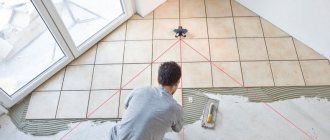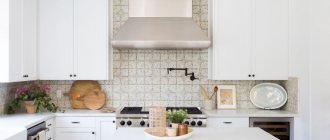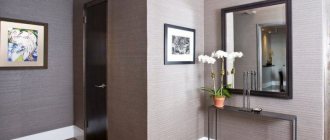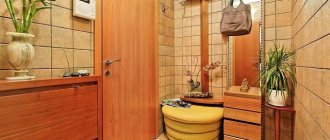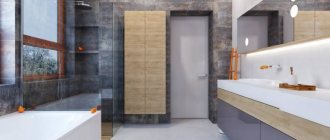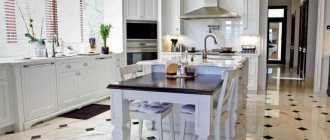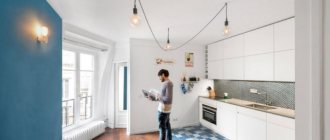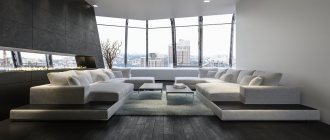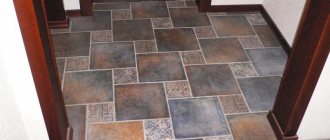Advantages and disadvantages of tiling flooring
In addition to dirt and water, sand and salt get into the corridor.
They are frequent visitors, especially in winter. Therefore, special requirements are placed on the flooring in the hallway. In addition to strength, water resistance and durability are essential.
It is believed that wooden floors are an almost ideal option. And they are preferred for the naturalness and environmental friendliness of the coating. But no matter how carefully the surface of the board is treated, sooner or later it will become unusable due to constant contact with water.
Linoleum is also popular. It is washable and waterproof. With proper care it lasts a long time. But this material is easily deformed. And in the corridor, the load on the floor increases, especially in winter.
And only tiles meet all the above requirements. In addition, it has many advantages:
- The smooth surface is easy to clean from dirt.
- Not at all afraid of water.
- Withstands heavy loads and even impacts.
- The tiles are completely fireproof.
- Can cool the room in hot weather.
- The damaged part of the floor can be easily replaced.
- Harmless to humans.
The shortcomings of the material are minor and can be easily eliminated. The main highlight is weak sound insulation, but in the hallway this is not as important as in the bedroom. Surface may be slippery.
In addition, the material can be easily combined with others. For example, tiles and laminate go well together in one room. True, the room should not be small.
Types of floor tiles
There are three main types of flooring materials. But in reality there are many more. Each species has its own subspecies. There are also materials that are rarely used as floor tiles anymore. But they still have fans. For example, tiles with a solid or porous structure. Either made using mono- or bicottura technology.
Ceramics
Classic material for flooring. The tiles have gained popularity due to their high hygienic properties. Dirt does not stick to the surface and is very easy to remove. In addition, the material has high indicators for various durability. The tile holds water well, has high impact resistance and is resistant to abrasion.
Facing the hallway with ceramic tiles with different textures Source evrookna-mos.ru
In addition to the classic options with a glossy or matte surface, you can find many modern types on sale. Relief tiles for the street are especially valued. But lappatted, polished and glazed are no less popular. There are about ten types in total, which differ in manufacturing technology and additives to the main raw materials.
Floor tiles for the hallway, made of ceramics Source dillmart.ru
Ceramic tiles are divided into three categories based on moisture resistance. The first group is the highest quality, since it has low moisture absorption, which helps to increase frost resistance. The material does not conduct electricity and is completely non-flammable. Therefore, they prefer to lay such tiles not only in the hallway, but also in the kitchen.
An original path in the corridor using two different tiles Source decorationinfo.ru
A popular type of ceramic is clinker. It differs in the annealing method and is more resistant to moisture. The surface of such tiles is often glazed. Less often left matte.
Clinker tiles on the floor in the hallway with an original pattern Source plitka-sdvk.ru
Porcelain tiles
Those who want to add an element of individuality to their hallway should consider this material. Porcelain tiles have an excellent appearance and are highly practical due to their durability. On average, according to the Friedrich Mohs scale, the material has a load resistance rating of 7.
Floor tiles on the floor in the hallway, made of porcelain stoneware Source yut-dom-org.ru
Manufacturers produce tiles of various thicknesses. It is produced from 7 to 30 mm and therefore the client will always find the option that best suits his case. In addition, the material easily tolerates frequent temperature changes, which makes it popular for rooms with close proximity to the street.
The floor in the hallway with an original pattern made of porcelain tiles Source prihozhaya.guru
In addition to high strength, the tiles have excellent resistance to chemicals. But the exception is hydrofluoric acid, which corrodes granite. And the material is valued for its ability, when properly installed, to eliminate any surface imperfections.
Porcelain tiles on the floor of the hallway, decorated in a luxurious classic style Source roomester.ru
Criteria for choosing tiles for the hallway
When choosing a floor covering, it is always necessary to take into account the specifics of the room. In the corridor there is high load on the floor - heels, dirty shoes and high traffic. Not all materials can withstand such conditions.
Of course, you can limit yourself to ordinary linoleum with a high wear resistance class. But what if you want something more sleek and elegant? And this is where modern floor tiles come to the rescue.
Consider these nuances:
- Choose a material that is not afraid of mechanical damage. Including abrasive influences, detergents, household chemicals;
- Seal the joints to prevent dirt and water from accumulating between them. A special waterproof putty will come to the rescue;
- Don't forget about dirty shoes when choosing a tile color. And then the corridor will always be clean and well-groomed;
- Remember safety. Choose collections with a special non-slip coating or textured tiles, which you can safely walk on in wet shoes after rain and snow.
Ceramic tiles “under laminate”
For a long time, apartment owners and homeowners actively used laminate as the main flooring material. However, compared to tiles, it is much less durable and practical. What to do? Abandon many years of tradition? Manufacturers came up with a solution - they began to produce tiles styled like laminate.
Externally, it is very difficult to distinguish - tile manufacturers are so meticulous in conveying the nuances of the texture of the popular flooring material.
It looks like a good laminate of at least class 33, but will last much longer - once again we raise the topic of the durability of tiles as a flooring material.
You definitely won't be able to get this floor dirty. The somewhat dirty, deliberately careless texture creates a soulful and warm atmosphere in the room.
Methods for laying tiles in the hallway
The following techniques are used for installation:
- The usual one is used for large spaces, and the best effect is obtained by combining tiles of different colors.
- Offset laying is suitable for rectangular corridors. Tiles of different colors look attractive. This is how a coating is laid that imitates natural materials.
- Narrow rectangular tiles, including those similar to parquet, are laid using the herringbone method.
- Parquet laying is used to lay out ceramic tiles that imitate a wooden surface.
- The modular installation begins with an ornament in the center of the corridor and continues along its perimeter.
Choose a grout that prevents dirt and water from accumulating in the seams. Make the joints dark to make them easier to clean.
A diagonal with non-parallel walls visually expands a narrow corridor.
To imitate carpets, tiles with a variety of ornaments and patterns are used.
The tiles are combined with other finishing materials, and the edges of the cladding adjacent to the corridor need to be decorated.
Options for designing junctions
Now we invite you to see what a hallway might look like with tiles around the front door. Below you will see photographs with design options, and perhaps one of them will appeal to you and will be able to decorate your home:
Types of tile coverings
Ceramic tiles
This is exactly the type of coating that is implied by the word “tile”. Floor tiles in a hallway differ in many ways from those used in a kitchen or bathroom. It has a much higher density, thickness and grain size. Thanks to these qualities, the material is able to withstand shock and pressure.
The average price of ceramic tiles is from 200 to 1000 rubles per square meter. The price depends on the manufacturer, the newness of the collection and the design. Many companies make patterned tiles from wood or stone, but ceramic tiles remain the most popular flooring option.
Interior tiles look simple, but will last a long time due to increased safety
Porcelain tiles
Porcelain tiles have an excellent appearance and are very practical due to their durability. According to the Friedrich Mohs scale, the material has a load resistance rating of 7.
Manufacturers produce tiles of different thicknesses. It ranges from 7 to 30 mm. In addition, the material easily tolerates frequent temperature changes, which makes it popular for rooms close to the street.
In addition to high strength, the tiles have excellent chemical resistance. The exception is hydrofluoric acid, which corrodes granite. In addition, the material is valued for its ability to eliminate any surface defects when installed correctly.
Vinyl
Vinyl tiles are made from rubberized plastic and stone chips are added to the mixture. Advantages of vinyl: no seams during installation, increased strength and high resistance to mechanical damage.
Vinyl tiles seamlessly replace natural materials in an open area
Quartzvinyl
Tiles are made by combining different materials. In essence, this is a modern PVC surface. Thanks to its excellent wear resistance, it is designed for places with large crowds of people and high traffic.
The tile consists of four layers:
- The first one is made of polyvinyl chloride. Provides reliable attachment to the surface.
- The second one is made of fiberglass, which increases its load-bearing capacity.
- The third strengthens. Made from quartz and vinyl.
- The fourth layer is protective. It consists of polyurethane. It also performs a decorative function.
The material has excellent soundproofing properties compared to others. It has a number of advantages. For example, it is perfect for “warm floors”. Although artificial materials are used in the manufacture of tiles, they are completely safe for humans, as they remain environmentally friendly.
Multilayer tiles
It consists of several layers. The first is thickened polyvinyl chloride, the second is a ceramic base with the addition of granite particles, then a layer of pigmented and green grass. The obvious advantage of such tiles is its high strength. In addition to this, it is not as cool as regular ceramic tiles, but is a bit like laminate.
PBX
Polyvinyl chloride is linoleum that is laid in small parts. Visually, linoleum goes well with ceramic tiles. The coating is soft and easy to install. The natural advantage of linoleum is its low price, but there is also an obvious drawback - it quickly breaks from mechanical damage.
High-quality linoleum replaces ceramic tiles in an open area
Clinker
Clinker is a small brick that has a rectangular shape and is fired using a special technology. Sometimes it is glazed and uneven. Clinker is used not only on walls, but also on open floors.
Clinker brick highlights a small area in the house or hallway
Applying texture
It is not comfortable to move on a relief surface.
Therefore, designers implement alternative options:
- The glossy surface of the flooring visually expands the space due to its reflective capabilities. This is the same drawback: the slightest scratches are visible.
- It is beneficial to use a matte finish. Due to the reduced reflectivity, dirt is hardly noticeable. Therefore, the primary colors appear better.
- Light shimmers on the satin finish, highlighting the decorative elements of the tiles.
- Structural tiles are an economical option for products that imitate the look of wood or stone.
Sizes and shape of tiles
Available in various sizes and shapes. With the right combination, you can achieve a visual expansion of the corridor or correct errors after renovation. The shape of the tiles is square, rectangular, hexagonal, and curly.
Rough tile installation takes less time, but fewer joints provide a cleaner finish. Small tiles reduce the amount of trimming work and make small patterns attractive.
Based on the technical and decorative characteristics of the material, the problems of a specific room and its arrangement are solved.
Expansion of space in a narrow corridor is achieved:
- Striped tiles with alternating light and dark lines;
- Finished with large sized tiles in shades of blue, gray, brown;
- Using bright glossy tiles;
- Using the same materials at the intersection of the corridor with other rooms;
- Zoning the space through a combination of different materials;
- A combination of black and white tiles or highlighting light and dark areas.
Techniques for arranging spacious rooms:
- Use of figured and metlakh tiles in the form of a mosaic;
- Application of large tiles with a three-dimensional pattern;
- Laying carpets with mosaics on the sides in the center of the room.
In the hallway, tiles of higher density and resistance to detergents are used. The place for meeting guests is decorated in the form of a colorful carpet or ornamental motifs.
Decor with imitation wood, laminate, marble, granite, onyx will add originality to the interior, and geometric patterns will add aristocracy.
Based on the characteristics of each type of tile and decorative effect, it is necessary to determine its position on the surface.
Porcelain tiles: main advantages
Porcelain stoneware tiles are chosen for finishing the floor of the hallway area more often than ceramics and tiles, which are much inferior in strength. These models are more suitable for decorating a bathroom and toilet. It is better to choose a more durable and wear-resistant finishing material for the hallway. A wealth of colors and textures will help you choose exactly the option that will be appropriately combined with wall decoration and furniture.
Porcelain tiles in the hallway
Matte porcelain tiles in the hallway
Each type of tile has its own characteristics and advantages. Speaking about porcelain stoneware material, its advantages should be noted:
- high quality of products due to the use of modern technologies in production;
- environmentally friendly composition of the components present in the tiles;
- increased wear resistance - perfectly withstands mechanical and static loads, is not afraid of chemical and thermal effects, ultraviolet radiation;
- low moisture absorption;
- not afraid of fire;
- withstands temperature changes well and has frost-resistant properties, which is why the material is often chosen for outdoor use;
- increased hardness and reliability, so chips, scratches and other defects do not form on the tile;
- suitable for installing heated floors;
- long service life - porcelain stoneware can easily last more than 20-30 years and at the same time maintain its original appearance;
- practicality - the tiles are excellent and easy to clean, it is very easy to remove any dirt from them;
- rich palette of colors and shades;
- wide choice of textures.
In the hallway, porcelain tiles look stylish and impressive. It is no coincidence that it is chosen specifically for these premises, because it can withstand a variety of loads and is highly wear-resistant. Even with strong impacts, the tile remains smooth and does not chip.
Small porcelain tiles in the interior of the hallway Porcelain tiles in the hallway in the Art Nouveau style
Palette of shades
By placing light tiles in the hallway, you can visually move the room away. A snow-white palette, beige, grayish shades, walnut and pastel colors are excellent options for this. But such tiles on the wall require constant attention, as dirt is immediately noticeable.
However, this feature is also characteristic of a dark floor, when it is very smooth and even small scratches are visible. In addition, such a shade can significantly limit an already small space.
The best options for floor tiles in the hallway are shades of muted tones.
Pay attention to the color. Any cold and dark shades visually contribute to the removal of objects. The property of light colors is to bring them closer together.
Black
A hallway with a black floor should be spacious enough, otherwise the color will narrow the space even more. On this type of floor the damage is most noticeable. Therefore, black tiles are often combined with white tiles, arranged in a checkerboard pattern.
Gray
The most popular and winning option for the hallway, it harmonizes with any wall design. Scratches and dirt are not so noticeable on it.
Beige
Beige belongs to neutral and warm tones. Such a floor in the hallway would rather serve as a backdrop for decoration than attract attention.
Blue
The choice is controversial, which is why it is more common in two-tone floors.
In the photo, a contrasting blue border favorably complements the ornament on a white background.
Red
This color in the hallway is often used in combination with white or as part of ornaments in muted tones - pink, burgundy.
White
Glossy white looks elegant and can be combined with any shade. Bright tiles reflect light and expand the space. But for a hallway this is an excessively slippery coating, and on products with a rough surface and light grouting, the dirt will be more noticeable.
The photo shows white tiles at the entrance, combined with the walls and light wood.
How to choose the right porcelain tiles for the hallway?
Porcelain tiles are superior in their technical and operational properties to ceramic and tiles. All this is thanks to special impregnation and ultra-resistant paint, hence the durability of porcelain stoneware products. However, when choosing products you should be extremely careful and attentive.
Before purchasing, pay attention to the integrity of the tiles; there should be no chips or scratches on them. The paint should be applied evenly, without streaks. The drawing must be clear. As a rule, many people trust those manufacturers who have been presenting their products on the market for several years.
Porcelain tiles with a geometric pattern in the hallway Glossy porcelain tiles in the hallway Stone-look porcelain tiles in the hallway
When choosing porcelain tiles for the floor in the corridor, decide on the exact number of tiles. When calculating the amount of finishing material, the floor area, length and width of one tile are taken into account. As a rule, the resulting amount is rounded to the highest value. To calculate the exact amount, you can use a special online program.
Porcelain stoneware brick tiles in the hallway
Porcelain tiles in the hallway
What tiles look like in different styles
Thanks to its variety, ceramic coating is suitable for all styles.
Modern
Style is based only on practicality. But don’t forget about the attractive component. The design should look good and fit the overall concept of the room.
Based on practical decisions, only the most affordable materials are selected. Also for the same reason, a dark design option is more justified. But finishing in a light style is allowed if the concept does not require it. There are no restrictions on the palette.
For finishing, you can choose monolithic blocks or with a clear geometric pattern. It is allowed to dilute large elements with small inserts. The essence of the idea is the unification of opposites.
For modern style, any experiments are acceptable. You can abandon generally accepted norms and lay out the floor with small light tiles, surrounding it with dark walls. An interesting option with a black floor and white walls. You can try to assemble a multi-colored mosaic on the surface. The main thing when finishing is to be guided by practicality.
Minimalism
For minimalism, choose one tile in a basic shade. The rigor and simplicity of minimalism should also be shown in the flooring.
Loft
Thanks to its variety, ceramic coating is suitable for all styles.
Lofts prefer (often distressed) faux wood floors in the hallway. Minimalism is characterized by tiles with a laconic pattern: white, gray, with the texture of concrete. Floor products imitating natural stone emphasize the sophistication of the classics.
The photo shows a loft-style hallway with black and white patterned tiles.
Provence
For a stylish interior, a light floor made of small bricks and figured fragments is suitable. This design takes on the features of lightness and romanticism inherent in the casual style. If you don’t want to focus attention on the floor, take tiles that imitate existing parquet in a light shade.
Scandinavian
In the Scandinavian style, patchwork is now more popular. Adherents of high-tech choose a modern design for the hallway floor, emphasizing the smooth lines of furniture and decor.
If you adhere to traditions, the style involves the use of a large number of white surfaces. This is due to the fact that in Scandinavian countries there is no sun for more than half the days of the year. Therefore, light glossy surfaces with a minimum of ornaments and designs are popular.
The ability to diffuse low light is important in small, cramped hallways. Therefore, in narrow hallways the use of white Scandinavian style is completely justified.
But you can give preference to light brown tones. In this case, the tiles are selected to imitate wood. The floors are tiled with brown tiles, and one of the walls is tiled in the same color. It is best to take the one with furniture. The remaining surfaces remain as light as possible.
Classic
The classic interior uses light colors, glossy surfaces and natural materials. For a stylish setting, choose marble tiles with gold or silver embellishments, bold patterns and a vibrant appearance.
Floor in the kitchen and living room
The flooring in the studio space of the kitchen-living room can play the role of a zoning element. In some projects, there is a combination of two types of materials in floor finishing, the junction of which becomes a conventional boundary between functional areas. It is logical to assume that in the kitchen, especially in the “wet” area, it is preferable to use moisture-resistant floor coverings, such as porcelain stoneware, for example. But the sofa area should look as cozy as possible, so here you can use engineered boards or parquet to design the floor. However, if your living room is an extremely presentable room in the spirit of glamorous Art Deco or artistic modernism, then expensive porcelain stoneware will also be suitable as a floor covering.
Sweeping patterns in kitchen floor design
All photos Light porcelain tiles with swirls in a pattern in the interior of the kitchen in the Grand Park residential complex.
The beige floor in the kitchen is decorated with swirls in light coffee and chocolate shades, which echo the color of cabinet furniture with glossy facades and soft chairs in the dining area. This porcelain stoneware flooring can be called traditional for interiors in Art Deco and Neoclassical styles.
Milk coffee floor in the living room
All photos Living room in silver tones with a floor in a milky-coffee shade
The flooring in a coffee-with-milk shade harmoniously fits into the interior of the living room in silver tones. In contrast to the sparkling mother-of-pearl materials that dominate the composition, the floor turned out to be completely matte. In order to emphasize the unity of the premises in the apartment, the same flooring is used in the hall as in the living room combined with the kitchen.
Strict geometry in floor design
All photos Strict geometric lines of the floor in the living room with a poster
The strict geometry in the design of this floor fully corresponds to the concept of a modern living room with a poster. Dividing the cover into squares looks harmonious in a monochrome room with a bright color detail in the form of a red leather pouf. This pattern in the floor decoration adds rhythm to the space.
Porcelain tiles with marble texture
All photos Large living room with white floor in the Andreevsky Park community complex
It’s no secret that marble always looks expensive and presentable. However, this material itself is quite difficult to care for. Marble requires special cleaning products, it can also be easily damaged, so it must be handled with extreme care, which can present some difficulties if you have children in your home. Porcelain stoneware can be a worthy and more practical alternative to marble finishing. Unlike marble, this material is much less demanding to maintain. In the interior of the large living room shown in the photo, white porcelain tiles with gray veins are stylized to resemble marble textures.
Floral patterns in the design of ocher floors
All photos Design project of a living room with floral patterns in the flooring design
And to create such a floor, you will need to develop individual sketches, according to which subsequently floor panels from porcelain stoneware will be made by laser cutting. The floral patterns on the ocher background may have been inspired by designs on the family coats of arms of European aristocratic houses. Compared to the walls and ceiling decorated with stucco patterns, the floor turned out to be quite dark. Such a floor surface will not create any maintenance difficulties for the owners.
Neoclassical living room with parquet
All photos Interior of a neoclassical living room with parquet
The bright living room in the neoclassical style with parquet laid in neat squares turned out to be very cozy and, at the same time, quite representative. This type of flooring, due to its neutrality, fits perfectly not only into neoclassicism, but also into modern style and even loft. Compared to the light walls, decorated with damask wallpaper inserts, and the white ceiling, the floor appears darker.
Solid plank for a modern white living room
All photos Solid boards are used to decorate the floor in the modern living room in the Zhukovka XXI Century CP.
The interior of a white living room in a modern style is based on the principles of symmetry, the axis of which is a partition with a fireplace. To emphasize the closeness of space to nature, our designers, in addition to the hearth and stone texture, also turn to natural elements in decoration. Therefore, instead of the usual and cheaper laminate, solid boards are used in floor design. This type of flooring, thanks to the natural wood in its composition, helps make the space more comfortable. And the special coating of the board allows this floor not to lose its presentable appearance for a long time.
Combining tiles with other coatings
To zone the space, combinations with other materials are used. In order for the transition from one area to another to be smooth and harmonious, it is necessary to properly design the joints. The seam can be straight or curly, depending on the materials used.
You can combine tiles with parquet, linoleum, and carpet.
The area at the entrance, covered with ceramics, may be higher than the rest of the floor, but not more than 5 cm.
The combination with laminate gives a decorative effect and at the same time divides it into 2 zones: the entrance and the one where you can walk barefoot or in slippers.
Design options for the interface between laminate and tiles:
- A flexible profile is used.
- Decorative flexible strip with a wavy edge.
.
A connecting profile along the edge with carpet and linoleum is also used.
In this case, not so much aesthetics are taken into account as the safety of the structure. A reliable option would be to seal the seam with silicone to match the color of the lining or use a cork condenser.
The floor is selected in the style of the general layout of the house or individually for the hallway. In any case, you must be guided by the features of the style.
Tiles and linoleum
This type of docking is cheaper and less problematic. Linoleum can be cut in different ways, for example, in a wave or in a semicircle. To combine space and eliminate floor differences in the hallway, a metal threshold is usually used.
The photo shows ceramic trim on the threshold and laid linoleum in the rest of the corridor.
Parquet and tiles
Parquet is the most vulnerable floor covering. It is definitely not possible to use parquet flooring in the hallway. It is very soft and scratches easily. Absolutely all objects, including heavy and hard ones, enter the apartment through the front door. Hence the rule:
If you use parquet throughout the apartment, then at the entrance to the corridor you must create a tile area.
The good news is that parquet goes well with level 1 tiles. Both materials are glued together; both do not require a buffer zone at the joint. Thus, the parquet and tiles fit perfectly next to each other, and the seams are filled with mortar.
Some take risks and make the floor in the hallway from natural wood.
Tiles and laminate
Absolutely pointless option. We have already found out that there is no point in using tiles in the entrance area and laminate in the rest of the apartment, because laminate will withstand everything without problems.
The most important thing is that the laminate cannot be joined to the tile level. The tiles are fixed with glue; the laminate must be laid loosely, with gaps in front of the wall. This is an important technological aspect.
Rule: we make the joint in the narrowest place, preferably under the door.
Tiles and laminate don't go together. No matter how hard you try, the joint will look bad.
The grout for the floor in the hallway should be very dark.
If you really want to create a tile island in your hallway, at least make it a normal size to keep dirt out of the joint. It is better to tile the entire area up to the door or arch or not lay it at all.
The best option is to lay either only tiles or only laminate throughout the entire corridor.
Pros and cons of combined flooring
Elegant combination of different materials on the kitchen floor
A popular modern trend is the visual division of the kitchen into a dining area and a cooking area. When solving the problem of combined floors, you should pay attention to the combination of floor coverings.
The main advantages of the combination of materials:
- the opportunity to make the kitchen more comfortable;
- it’s easy to keep the food preparation area clean and have a more aesthetically pleasing and comfortable surface near the dining table;
- proper zoning of the kitchen space;
- practicality and hygiene;
- protection against premature wear of materials in those areas that can withstand maximum load.
The disadvantages of this combination include:
- the difficulty of choosing materials from which a harmonious combination can be obtained,
- the need for additional processing of joints,
- asymmetry of the room with poorly thought out placement of different surfaces.
If combining laminate with traditional porcelain tiles is not difficult, it is necessary to provide for a combination of tiles and linoleum at the stage of leveling the surface.
Combination options
As a rule, floor tiles are installed only in technological rooms. Such as the hallway, bathroom and kitchen. A private house may also have storage rooms and a boiler room. In living rooms, the floors are covered with a different material. In modern realities, the popularity of laminate has grown sharply.
Dividing the hallway into two zones by joining tiles and laminate Source design-homes.ru
The material is valued for its beauty, as it imitates any natural raw material well. And also for a reasonable price. But if the joint between the floor tiles and the laminate is not decorated, it will be conspicuous and ruin the entire look of the room. Therefore, it is necessary to correctly arrange the transition between different materials.
For these purposes, the following techniques are used:
- Docking with connecting profiles.
- Closing with a floor threshold.
- Decorating a curved joint.
- Transition without thresholds.
The combination of tiles and laminate in the hallway not only looks beautiful visually, but also has practical purposes. The room is divided into zones. In one it is permissible to wear street shoes, while in the other you can only walk barefoot or in house slippers.
Porcelain stoneware floor tiles and laminate in the hallway Source postroika.biz
But it is technically impossible to simply adjust the joints between two different materials. This is all due to the properties of the laminate. If the humidity or temperature in the room rises, the material increases in size. In the absence of a technological gap, this is fraught with swelling.
At this point you can start to stumble and in the process break the laminating film. When the laminate goes back into place, it will lose its attractive appearance. Therefore, when laying floors with different materials, a gap must be left between them, which is subsequently used to decorate.
The subtleties of laying tiles on wooden floors
Laying tiles on a wooden floor in a hallway is considered a long and complex process. These two materials do not combine well with each other and have different characteristics:
- A tree can change in size under the influence of external factors. As humidity increases, the tree expands. Decreases - the wood shrinks. As a result, the top coating is deformed and cracks may appear;
- Wood floors are more susceptible to deterioration than tile floors. Therefore, it is often necessary to re-dismantle the tile covering;
- The adhesive (water repellent) and tiles prevent air from getting into the wood. It is necessary for the tree to work fully. As a result, the base wears out much faster than expected;
- The tile laid on top of the wood should be as light as possible, otherwise over time it may crack in places under the weight of the tile cladding.
It is strictly forbidden to engage in masonry work on a wooden base if two years have not yet passed after installation. If you rush, the tiles will certainly crack when they shrink.
Pros and cons of using tiles in the hallway
Decorative tiles are today recognized as the best material for finishing the floor in the hallway of a city apartment. The paved floor has its own characteristics:
| Advantages | Flaws |
| Durability and wear resistance: it lasts a long time, withstands loads and exposure to detergents well. | Glossy tiles have a high slip rate, so a matte type of material is suitable for the floor in the hallway. |
| Fire resistance. Makes it possible to install heated floors. | Rapid contamination of embossed or light-colored coatings. |
| Hygiene and moisture resistance. Does not absorb foreign odors and fat, prevents the formation of mold. | The surface of the tiled floor is quite cold; it is not recommended to walk on it without shoes. |
| The products are relatively easy to restore: in case of damage, there is no need to completely change the coating. | Low sound insulation. |
Features of heated floors
There are certain advantages of having a heated floor under the tiles:
- environmental Safety;
- favorable temperature conditions;
- increased surface area due to the absence of heating radiators;
- The warm tiles feel good on your feet.
The disadvantages include the complexity of the work and the need to carefully level the surface before installation. Also, during repair of the heating system, all tiles will need to be completely removed.
Tile texture
There are options for wood, stone, brick, as well as mirror surfaces and imitation minerals. Natural stone tiles will be needed to embody the style of modern and rustic interiors. Tiles with a fine-grained texture and smooth stone pattern will be appropriate in almost any setting. Terracotta tiles imitate a monotonous reddish stone surface. The “ragged stone” texture depicts the surface of a thick, chipped stone. There are also many options for wood. The texture imitating chipped wood is an excellent companion for a loft-style interior. Neat concentric circles on the tiles will harmoniously fit into the “Scandinavian” decor. Mirror tiles, as well as imitation chrome surfaces, are suitable for arranging a beautiful corridor with designer furniture. Such options are also useful for housing in high-tech, glamor and avant-garde styles.
Photo of floor tiles in the hallway
Style solutions
Basic styles for decorating the floor in the corridor:
- Classical.
- Modern.
- Scandinavian.
- Loft.
- High tech.
Among them there are 3 “general” ones: classic, modern and hi-tech. Scandi and loft, in turn, are suitable for decorating original themed housing. As for the basic techniques for using tiles to decorate a corridor/hallway, we can distinguish 4 main areas. The first approach is standard. Select tiles of rectangular or square shape, one or several shades. At the same time, the color is consistent with the interior of the room and the entire home as a whole. The second option is to create drawings in the form of some abstract forms. The third installation method is somewhat similar, implying the presence of a certain type of pattern on each tile. The most original solution lies in using tiles with a certain texture or print. Including wood, stone, mirror surface, textile, metal. The transmission of each style can be enhanced by tiles with a textured surface.
Classical
Classic style includes the concepts of tradition, luxury and historical motifs. An expensive interior looks pointless in a cramped corridor. Otherwise, it's worth the effort. For a classic design, choose glossy tiles, porcelain tiles, and patterned elements. Design in a modern manner involves a light or reddish cladding with a moderate amount of decorative techniques. Creating a closed, dark-colored geometric shape on a light tile is just one of those. An additional option is a repeating pattern on a light or dark background, and in the second case it is better to choose brown, green or red. The cost of tiles for the implementation of classics will be many times higher than for a simple interior. You need to choose the right lighting fixture to match the glossy surface of the tile.
Modern
The style of the new era is based on the beauty of practical solutions. To match the style, it is necessary to comply with the general shape and concept of the room. Preference is given only to the most comfortable materials. Ordinary ceramic tiles can be “diluted” with small inserts. The main blocks are selected either monotonous or with a simple geometric pattern. Light and dark floor design options are good in their own way, but the second one is more justified. There are still no significant restrictions on color. Almost any of the most popular colors will do. In modern design there is also room for experiments that contradict generally accepted norms. Small light tiles surrounded by dark walls, a completely black floor with white walls, multi-colored mosaics, monotony, sharp contrasts and other options are acceptable if you follow one main rule - proceed from practicality. Almost any material will do.
Scandinavian
The owner of the living space usually has two options. Scandinavian style, on the one hand, goes well with a light brown floor, but on the other, it requires as many white surfaces as possible with a minimal shift towards some shade. Accordingly, the choice is between two options. The region of origin of the style is deprived of sunlight 150-200 days a year, and therefore visual lightening through surfaces and artificial objects is important. White glossy tiles, monotonous or with small geometric elements in bright colors, are an option for maximalists. This coating diffuses sunlight well and is suitable, in particular, for small hallways. This way the whole essence of the Scandi style is conveyed. A more trivial and far-sighted way to solve the housing problem is to decorate with tiles that imitate wood. In this spirit, you can decorate not only the floor, but also one of the walls, for example, behind a set of furniture. You will get a color distinction along the diagonal.
Loft
Stylistics is absolutely deservedly popular, because it allows you to compensate for some of the shortcomings, and even turn some of them into advantages. The style is characterized by dark and dirty tones, just the kind needed to hide stains. In addition, the loft style necessarily contains expressive textures. If the residents have old tiles, then with the overall design for a loft they will take on a current and modern look. A tile that imitates natural and industrial materials is ideal. For finishing, one or more types of coating are used - stylistics do not prohibit this approach. Graphite tiles, for example, are used to recreate the color of asphalt. A “softer” version is wood-look tiles. If in the first case we are talking about a “screaming” design, then in the second - about home comfort, “lamp-likeness”.
High tech
Strict tones prevail in the style. The direction itself primarily embodies the desire for technological capabilities and congenial design. Modern and traditional design methods are encouraged. Matte and glossy tiles of deep color are also suitable. On paper, you can try an option with a combination of tiles of different sizes. The easiest alternative to looking for an original design is large, single-color elements. The monochrome palette only at first glance makes the task of decorating the hallway easier. Based on the principles of stylistics, we need modern materials and complete harmony with interior objects and walls. At first, any option will seem better than it actually is, because the tiles will need to be combined with metals, mirrors, glass and various panels. The interior in the high-tech style is complex in execution, so the help of an expert will not hurt.
Tile geometry
The tile has several geometric shape options. Most often, square or rectangular materials are chosen; hexagonal or shaped elements are much less often purchased.
Tips for choosing tiles for the floor in the hallway
First of all, pay attention to the general characteristics and performance. For the corridor, choose tiles with a solid base, because the porous coating accumulates moisture faster. The acceptable porosity is in the range of 3-6%. The lower value is relevant for large private houses. In apartments, a higher level of porosity is allowed. A less porous material is primarily stronger in bending. Porcelain stoneware and unglazed tiles are used to make masonry near the front door. Shoes do not slip on rough surfaces, and in this regard, the best options are those with corundum coating. The type of surface also matters: on a glossy surface, scratches and other mechanical damage are more visible than on a matte surface. A tile with a large, complex pattern will hide stains and stains after washing. Tiles should be selected from products with abrasion class 3 or 4.
Basic dimensions of floor tiles for the corridor and kitchen
Manufacturers produce collections of standard sizes. For small rooms, it would be more practical to use tiles of 20×20, 20×30, 20×25, 30×30 cm. They will not require much cutting, and there will be much less waste during the installation process. A beautiful inclusion will be a pattern of small tiles 10x10 and 10x15 cm.
For large areas, you can choose larger sizes 33.3×33.3, 40×40, 60×100 or 70×120 cm. In the collections, designers select a harmonious combination of different sizes of tiles in the hallway on the floor. Photos of excellent solutions are presented in our gallery below.
Useful service:
Especially for our readers, we offer you to use a convenient online kitchen designer , which allows you to organize the kitchen space to your taste and quickly calculate the cost of the kitchen set.
Main quality indicators of floor tiles
To make tiles, a mixture of fine-grained white or red clay, sand and natural ingredients is used. Strength is imparted to the finished product by firing in special ovens at temperatures above +1000°C.
White clay tiles are softer than red ones. You can determine the original composition by the shade of the end. If red clay was used, the end is yellow or red. White clay does not stain tiles.
When choosing ceramic tiles for a hallway or kitchen, you need to take into account not only the aesthetic perception, but also the physical characteristics of the product, on which the performance indicators depend:
- strength;
- stiffness coefficient, which is directly proportional to the thickness of the tile;
- thermal conductivity, a high rate allows you to install a warm floor under the base;
- high fire resistance, thanks to which the tiles can be used as cladding for stoves and fireplaces;
- electrical insulation;
- the tile is resistant to chemical media, with the exception of hydrogen fluoride;
- fully complies with the requirements and standards of sanitary control, is not exposed to harmful microorganisms;
- Due to their high wear resistance, the tiles are popular for installation in high-traffic areas.
The wear resistance marking is indicated by the manufacturer on the packaging.
In addition, according to state standards, compliance with the following data is important:
- Wear resistance – up to 0.18 g/sq.m. cm;
- tensile strength – 28 MPa;
- the number of cycles to determine frost resistance is at least 25.
A practical solution for the kitchen
Visual increase in space
Tiles can visually expand the territory of the entrance area. To do this, use light colors and rectangular versions of the finishing material, laid along or across the hallway, depending on which part needs to be “pushed apart.” Square tiles laid diagonally can also increase the space.
It is necessary to take into account that:
- Large square elements will attract too much attention and optically narrow a small space;
- Tiles that are too small will not be very convenient due to the large number of seams in which dust will accumulate, and such diversity will reduce the available space.
